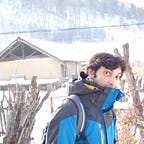Having dipped my toes (or Face) in the Virtual Reality Experiences, like most — I am totally blown away by the possibilities and potential VR holds as a Medium.
Some Background
Lately, I have started exploring ways I can create these Experiences with my team.
As with any new medium, Design for VR comes with its unique challenges and opportunities — I started with concept-work on the Launcher/Home/Lobby — the first place of contact when user puts on VR display.
What struck me was the degree of challenge, not just in the process of concepting, but also in collaboration and communication with the larger team.
So, I thought of documenting and sharing my experiences/learning here.
(Disclaimer: Images shown here are not the Actual concepts)
1. Conceptualizing Environments and Interactions in VR
I come from a UX/Design Research background, I though I should start with paper sketches and prototypes. While it worked for abstract IA maps, when it came to visually representing the idea — the process felt so rigid.
Visualizing depth, distances and layers on a sheet of paper seemed (and is) very complex and error prone. Also making modifications was slow and tedious
Tools and Methods we use often decide the quality of Outcomes- and in this case Paper as a medium didn’t offer the flexibility of exploration, neither felt like a natural fit.
So after little fiddling with some Post-it notes and some Office stationary, I made a setup — for simplicity sake, lets call it “POV (Point of View) setup”. — based on the goal of VR environment design — to see it from the Point of view of the user in VR.
Basically the setup allowed me to move things around, adjust the positions, perspectives, heights, distances etc….with WAY more flexibility than sketching these things on paper.
To get a “closer to reality” feel, a eye-level look at the setup would provide very Rich perspective on what works and what doesn’t.
This is not a new method per se- Architects have been using similar placements to represent environments. However, when it comes to UX and Design of VR environments, it offers more flexibility than paper sketches/prototypes used in Web/App contexts.
2. Collaboration
This was other important thing for me. Best ideas come from fusion of different perspectives — and so for VR, bringing together, Product Owners, Designers and User Research is invaluable .
We would often doodle on paper, share good examples from online research and findings from user research — We soon realized we needed a common way to capture and document these ideas in form or VR representations.
POV setup proved to be a fun way to play with ideas and collaborate. We would arrange objects in a certain way and look through our smartphone camera to get a point of view. Then document the setup from different perspectives.
3. Communication
This was Big one! especially when it comes to sharing with Management, Development & Engineering teams .
For a similar project in App Design — normally, designers would build a high level UI visualization or Product manager would create a slide deck as exploratory proposal.
However, visualizing VR environment on computer takes a lot of time, energy and resources. We tried using Unity for two concepts and realized its not a sustainable way at this early stage of exploration.
This was absolutely taken care of with this POV Setup. Super easy to explain. When someone challenged an idea or gave input, I would make the changes happen right away in the scene and we could see how it would feel like.
Next steps:
I think POV setup has lot of potential in terms of a prototyping and concepting method. It does not replace the prototyping work required Computer 3D environments, rather I think this can aid in speeding up the exploration process.
For now, I am exploring different ways, to make this POV more flexible and collaborative.
So hopefully, will have more to share in next update!
….till then Happy VR’ing!
